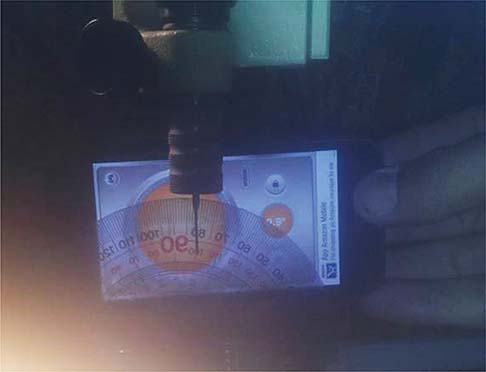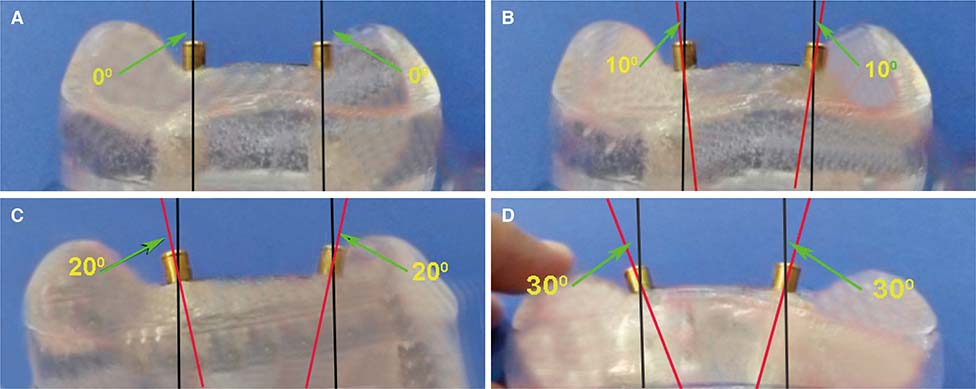J Adv Prosthodont.
2016 Apr;8(2):116-124. 10.4047/jap.2016.8.2.116.
Strains around distally inclined implants retaining mandibular overdentures with Locator attachments: an in vitro study
- Affiliations
-
- 1Removable Prosthodontics, Faculty of Dentistry, Mansoura University, Egypt. M_syad@mans.edu.eg
- 2Bachelor degree student, Faculty of Dentistry, Tripoli University, Libya.
- KMID: 2176649
- DOI: http://doi.org/10.4047/jap.2016.8.2.116
Abstract
- PURPOSE
The aim of the present study was to evaluate, by means of strain gauge analysis, the effect of different implant angulations on strains around two implants retaining mandibular overdenture with Locator attachments.
MATERIALS AND METHODS
Four duplicate mandibular acrylic models were constructed. Two implants were inserted in the canine regions using the following degrees of distal inclinations: group I (control); 0°, group II; 10°, group III; 20°, and group IV; 30°. Locator pink attachments were used to connect the overdenture to the implants and Locator red (designed for severely angled implants) was used for group IV (group IV(red)). For each group, two linear strain gauges were attached at the mesial and distal surfaces of the acrylic resin around each implant. Peri-implant strain was measured on loading and non-loading sides during bilateral and unilateral loading.
RESULTS
For all groups, the mesial surfaces of the implants at loading and non-loading sides experienced compressive (negative) strains, while the distal implant surfaces showed tensile (positive) strains. Group IV showed the highest strain, followed by group III, group II. Both group I and group IV(red) showed the lowest strain. The strain gauges at the mesial surface of the loading side recorded the highest strain, and the distal surface at non-loading side showed the lowest strain. Unilateral loading recorded significantly higher strain than bilateral loading.
CONCLUSION
Peri-implant strains around two implants used to retain mandibular overdentures with Locator attachments increase as distal implant inclination increases, except when red nylon inserts were used.
Keyword
MeSH Terms
Figure
Reference
-
1. Mericske-Stern R, Zarb GA. Overdentures: an alternative implant methodology for edentulous patients. Int J Prosthodont. 1993; 6:203–208.2. Feine JS, Carlsson GE, Awad MA, Chehade A, Duncan WJ, Gizani S, Head T, Lund JP, MacEntee M, Mericske-Stern R, Mojon P, Morais J, Naert I, Payne AG, Penrod J, Stoker GT Jr, Tawse-Smith A, Taylor TD, Thomason JM, Thomson WM, Wismeijer D. The McGill Consensus Statement on Overdentures. Montreal, Quebec, Canada. May 24-25, 2002. Int J Prosthodont. 2002; 15:413–414.3. Heckmann SM, Winter W, Meyer M, Weber HP, Wichmann MG. Overdenture attachment selection and the loading of implant and denture-bearing area. Part 2: A methodical study using five types of attachment. Clin Oral Implants Res. 2001; 12:640–647.4. Chikunov I, Doan P, Vahidi F. Implant-retained partial overdenture with resilient attachments. J Prosthodont. 2008; 17:141–148.5. Kleis WK, Kämmerer PW, Hartmann S, Al-Nawas B, Wagner W. A comparison of three different attachment systems for mandibular two-implant overdentures: one-year report. Clin Implant Dent Relat Res. 2010; 12:209–218.6. Krennmair G, Seemann R, Fazekas A, Ewers R, Piehslinger E. Patient preference and satisfaction with implant-supported mandibular overdentures retained with ball or locator attachments: a crossover clinical trial. Int J Oral Maxillofac Implants. 2012; 27:1560–1568.7. ELsyad MA, Errabti HM, Mustafa AZ. Mandibular Denture Base Deformation with Locator and Ball Attachments of Implant-Retained Overdentures. J Prosthodont. 2015; 09. 16. DOI: 10.1111/jopr.12356.8. Sadig W. A comparative in vitro study on the retention and stability of implant-supported overdentures. Quintessence Int. 2009; 40:313–319.9. Porter JA Jr, Petropoulos VC, Brunski JB. Comparison of load distribution for implant overdenture attachments. Int J Oral Maxillofac Implants. 2002; 17:651–662.10. Duyck J, Rønold HJ, Van Oosterwyck H, Naert I, Vander Sloten J, Ellingsen JE. The influence of static and dynamic loading on marginal bone reactions around osseointegrated implants: an animal experimental study. Clin Oral Implants Res. 2001; 12:207–218.11. Gotfredsen K, Berglundh T, Lindhe J. Bone reactions adjacent to titanium implants subjected to static load of different duration. A study in the dog (III). Clin Oral Implants Res. 2001; 12:552–558.12. Geng JP, Tan KB, Liu GR. Application of finite element analysis in implant dentistry: a review of the literature. J Prosthet Dent. 2001; 85:585–598.13. Ogawa T, Dhaliwal S, Naert I, Mine A, Kronstrom M, Sasaki K, Duyck J. Effect of tilted and short distal implants on axial forces and bending moments in implants supporting fixed dental prostheses: an in vitro study. Int J Prosthodont. 2010; 23:566–573.14. Krennmair G, Fürhauser R, Krainhöfner M, Weinländer M, Piehslinger E. Clinical outcome and prosthodontic compensation of tilted interforaminal implants for mandibular overdentures. Int J Oral Maxillofac Implants. 2005; 20:923–929.15. Krekmanov L, Kahn M, Rangert B, Lindström H. Tilting of posterior mandibular and maxillary implants for improved prosthesis support. Int J Oral Maxillofac Implants. 2000; 15:405–414.16. Walton JN, Huizinga SC, Peck CC. Implant angulation: a measurement technique, implant overdenture maintenance, and the influence of surgical experience. Int J Prosthodont. 2001; 14:523–530.17. Sadowsky SJ, Caputo AA. Effect of anchorage systems and extension base contact on load transfer with mandibular implant-retained overdentures. Prosthet Dent. 2000; 84:327–334.18. Tokuhisa M, Matsushita Y, Koyano K. In vitro study of a mandibular implant overdenture retained with ball, magnet, or bar attachments: comparison of load transfer and denture stability. Int J Prosthodont. 2003; 16:128–134.19. Federick DR, Caputo AA. Effects of overdenture retention designs and implant orientations on load transfer characteristics. J Prosthet Dent. 1996; 76:624–632.20. Kenney R, Richards MW. Photoelastic stress patterns produced by implant-retained overdentures. J Prosthet Dent. 1998; 80:559–564.21. Ichikawa T, Horiuchi M, Wigianto R, Matsumoto N. In vitro study of mandibular implant-retained overdentures: the influence of stud attachments on load transfer to the implant and soft tissue. Int J Prosthodont. 1996; 9:394–399.22. Hong HR, Pae A, Kim Y, Paek J, Kim HS, Kwon KR. Effect of implant position, angulation, and attachment height on peri-implant bone stress associated with mandibular two-implant overdentures: a finite element analysis. Int J Oral Maxillofac Implants. 2012; 27:e69–e76.23. Celik G, Uludag B. Photoelastic stress analysis of various retention mechanisms on 3-implant-retained mandibular overdentures. J Prosthet Dent. 2007; 97:229–235.24. Pigozzo MN, Laganá DC, Sesma N, Souza GF, Ichi AL. Photoelastic stress analysis in mandibular bone surrounding bar-clip overdenture implants. Braz Oral Res. 2014; 28:pii: S1806-83242013005000034.25. Al-Ghafli SA, Michalakis KX, Hirayama H, Kang K. The in vitro effect of different implant angulations and cyclic dislodgement on the retentive properties of an overdenture attachment system. J Prosthet Dent. 2009; 102:140–147.26. Rabbani S, Juszczyk AS, Clark RK, Radford DR. Investigation of retentive force reduction and wear of the locator attachment system with different implant angulations. Int J Oral Maxillofac Implants. 2015; 30:556–563.27. Stephens GJ, di Vitale N, O'Sullivan E, McDonald A. The influence of interimplant divergence on the retention characteristics of locator attachments, a laboratory study. J Prosthodont. 2014; 23:467–475.28. Gonda T, Ikebe K, Dong J, Nokubi T. Effect of reinforcement on overdenture strain. J Dent Res. 2007; 86:667–671.29. Dong J, Ikebe K, Gonda T, Nokubi T. Influence of abutment height on strain in a mandibular overdenture. J Oral Rehabil. 2006; 33:594–599.30. el Charkawi HG, el Wakad MT. Effect of splinting on load distribution of extracoronal attachment with distal extension prosthesis in vitro. J Prosthet Dent. 1996; 76:315–320.31. Takeshita S, Kanazawa M, Minakuchi S. Stress analysis of mandibular two-implant overdenture with different attachment systems. Dent Mater J. 2011; 30:928–934.32. ELsyad MA, Elsaadawy MG, Abdou AM, Habib AA. Effect of different implant positions on strain developed around four implants supporting a mandibular overdenture with rigid telescopic copings. Quintessence Int. 2013; 44:679–686.33. Elsyad MA, Al-Mahdy YF, Salloum MG, Elsaih EA. The effect of cantilevered bar length on strain around two implants supporting a mandibular overdenture. Int J Oral Maxillofac Implants. 2013; 28:e143–e150.34. Uludag B, Polat S, Sahin V, Çomut AA. Effects of implant angulations and attachment configurations on the retentive forces of locator attachment-retained overdentures. Int J Oral Maxillofac Implants. 2014; 29:1053–1057.35. Evtimovska E, Masri R, Driscoll CF, Romberg E. The change in retentive values of locator attachments and hader clips over time. J Prosthodont. 2009; 18:479–483.36. Yang TC, Maeda Y, Gonda T, Kotecha S. Attachment systems for implant overdenture: influence of implant inclination on retentive and lateral forces. Clin Oral Implants Res. 2011; 22:1315–1319.37. Gulizio MP, Agar JR, Kelly JR, Taylor TD. Effect of implant angulation upon retention of overdenture attachments. J Prosthodont. 2005; 14:3–11.38. Koutouzis T, Wennström JL. Bone level changes at axial- and non-axial-positioned implants supporting fixed partial dentures. A 5-year retrospective longitudinal study. Clin Oral Implants Res. 2007; 18:585–590.39. Heckmann SM, Winter W, Meyer M, Weber HP, Wichmann MG. Overdenture attachment selection and the loading of implant and denture-bearing area. Part 1: In vivo verification of stereolithographic model. Clin Oral Implants Res. 2001; 12:617–623.40. Bevilacqua M, Tealdo T, Pera F, Menini M, Mossolov A, Drago C, Pera P. Three-dimensional finite element analysis of load transmission using different implant inclinations and cantilever lengths. Int J Prosthodont. 2008; 21:539–542.41. Watanabe F, Hata Y, Komatsu S, Ramos TC, Fukuda H. Finite element analysis of the influence of implant inclination, loading position, and load direction on stress distribution. Odontology. 2003; 91:31–36.42. Alsabeeha N, Atieh M, Swain MV, Payne AG. Attachment systems for mandibular single-implant overdentures: an in vitro retention force investigation on different designs. Int J Prosthodont. 2010; 23:160–166.43. Szmukler-Moncler S, Salama H, Reingewirtz Y, Dubruille JH. Timing of loading and effect of micromotion on bone-dental implant interface: review of experimental literature. J Biomed Mater Res. 1998; 43:192–203.44. Feingold GM, Grant AA, Johnson W. The effect of variation of residual ridge angle on partial denture abutment tooth movement. J Oral Rehabil. 1988; 15:379–384.45. Aka K, Cehreli MC, Iplikçioglu H. A comparison of threedimensional finite element stress analysis with in vitro strain gauge measurements on dental implants. Int J Prosthodont. 2002; 15:115–121.
- Full Text Links
- Actions
-
Cited
- CITED
-
- Close
- Share
- Similar articles
-
- Clinical evaluation of implant retained overdentures using two implant and Locator attachments in the fully edentulous mandibles
- Overdentures using newly designed metal ball attachment containing predetermined gap with stress breakers
- Effect of implant- and occlusal load location on stress distribution in Locator attachments of mandibular overdenture. A finite element study
- The Implant Retained Overdenture by Locator Attachments on the Edentulous Mandible: A Case Report
- Open and Closed Mouth Impression Techniques for Mandibular Implant Overdenture: Two Cases Report






